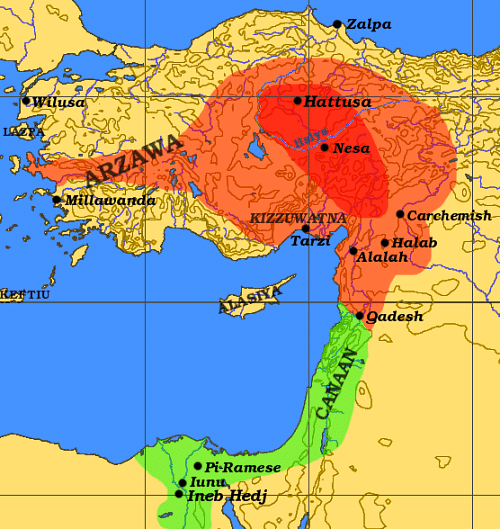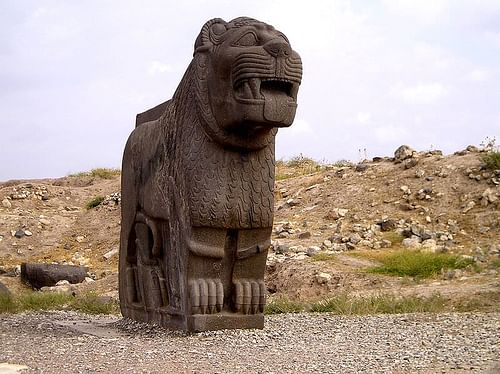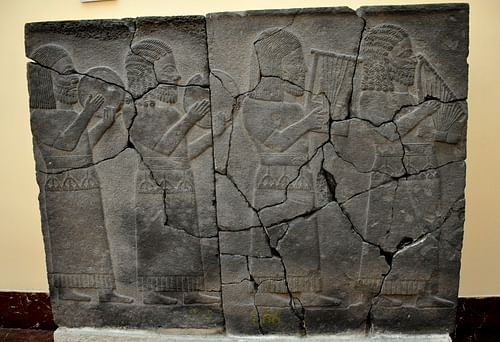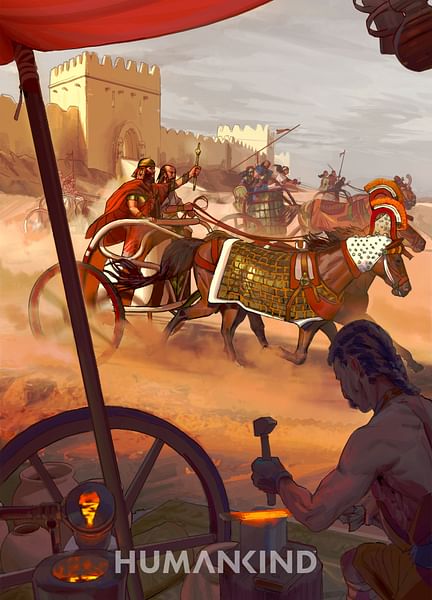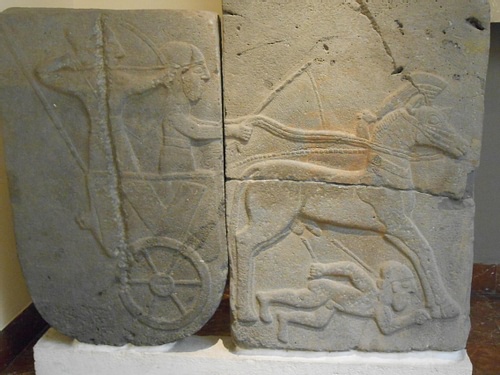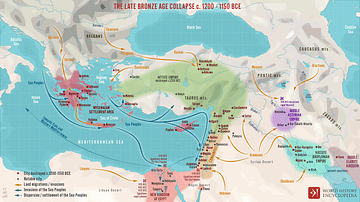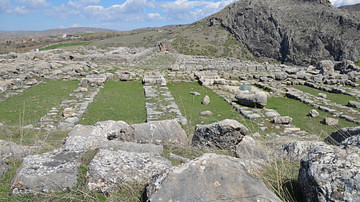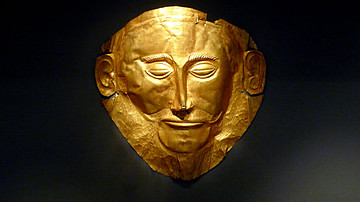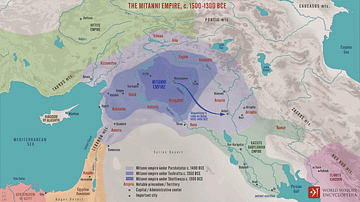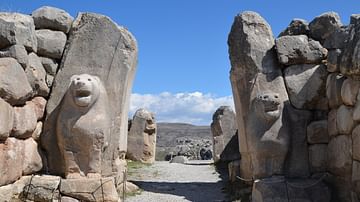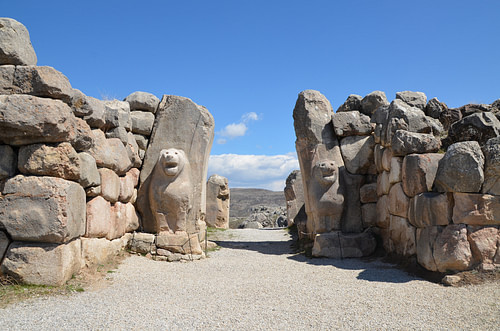
The Hittites occupied the ancient region of Anatolia (also known as Asia Minor, modern-day Turkey) prior to 1700 BCE, developed a culture apparently from the indigenous Hatti (and possibly the Hurrian) people, and expanded their territories into an empire which rivaled, and threatened, the established nation of Egypt.
They are repeatedly mentioned throughout the Hebrew Tanakh (also known as the Christian Old Testament) as the adversaries of the Israelites and their god. According to Genesis 10, they were the descendants of Heth, son of Canaan, who was the son of Ham, born of Noah (Genesis 10: 1-6). The name they are known by today, therefore, comes from the Bible and from the Amarna Letters of Egypt which reference a "Kingdom of Kheta" identified today as the 'Kingdom of Hatti' (the designation the land of the Hittites was known by) but their own documents refer to them as Nesili, as do others of the time.
The Hittite control of the region is divided by modern-day scholars into two periods:
- The Old Kingdom (1700-1500 BCE)
- The New Kingdom, also known as the Hittite Empire (1400-1200 BCE)
There is an interregnum between these two which, to those who accept that version of history, is known as the Middle Kingdom. The discrepancy between those scholars who recognize a Middle Kingdom and those who do not arises from the fact that there was no discontinuity between the Old Kingdom and the New, merely a 'dark age' of less than 100 years about which little is known. The Hittite Empire reached its peak under the reign of King Suppiluliuma I (c. 1344-1322 BCE) and his son Mursilli II (c. 1321-1295 BCE) after which it declined and, after repeated attacks by the Sea Peoples and the Kaska tribe, fell to the Assyrians.
Archaeology & Language
Little was known of the Hittites other than the references from the Bible and fragmentary documentation from Egypt until the late 19th century CE when excavations began at Boghaskoy (modern-day Bogazkale, Turkey) which was once the site of Hattusa, capital of the Hittite Empire. Historian Christopher Scarre describes Hattusa as
a vast fortress-city sprawling over the rocky terrain, with craggy citadels and elaborate temples. It became the center of a powerful empire that covered not only most of Anatolia but also at times extended far to the south, into Syria and the Levant (206).
Hattusa was originally founded by the Hatti (an aboriginal tribe of Anatolia) in 2500 BCE, and their culture may have provided the basis for that of the Hittites. This very important complex and those who built it along with their vast empire, however, remained almost unknown until their writings were discovered, first by the Irish missionary William Wright in 1884 CE, and then by the German archaeologist Hugo Winckler in 1906 CE.
By the year 1912 CE, Winckler “had recovered 10,000 clay tablets from the Hittite royal archives” (Scarre & Fagan, 206). These tablets, on which they had recorded their history and transactions, were deciphered relatively quickly. The historian Erdal Yavuz describes the process of decipherment in one instance (though there were other scholars who contributed to an understanding of the Hittite script, notably Archibald Sayce, to name only one):
Bedrich Hrozny, 1879-1952, a Czech professor at the University of Vienna, in 1916 deciphered the Hittite language. The starting point was a phrase on an inscription in cuneiform: `Nu Ninda-An Ezzateni, Vatar-Ma Ekuteni'. Since many Babylonian words were included in Hittite texts, the clue was provided by the Babylonian word `ninda', which means `food' or `bread'. Hrozny asked himself a simple question: What does one do with food or bread? The answer, of course, was one eats it. So the word `ezzateni' must be related to eating. Then the `-an' suffix on `ninda' must be a marker for a direct object. With these two propositions in hand, Hrozny looked at both the vocabulary and the grammar of Indo-European languages. He noted that the verb to eat is similar to the Hittite `ezza' – not only in English, but also in Greek (edein), Latin (edere) and German (essen), and especially in medieval German (ezzan). If that was true, the second line of the inscription was not much of a problem, since it began with the word `vatar', which could easily be translated as English `water' or German `wasser'. Hrozny proposed the reading of the whole sentence as “Now Bread You Eat, Water You Drink” and this turned out to be right for the whole Hittite language. It was of Indo-European origin. (1)
Once Hrozny's work was published, however, it initially both clarified and obscured the history of the Hittites. There had long been an accepted theory among scholars of ancient history that India was invaded from the north by Indo-Europeans known as Aryans (the so-called 'Aryan Invasion') and that, somewhere, there existed a homeland from which these invaders descended into India. The texts uncovered by Winckler seemed to corroborate this theory.
Since there was no evidence that Indo-European languages were known in Anatolia at that time, it was postulated that there had to have been some kind of invasion and, most probably, from the same mysterious homeland from which the alleged invasion of India was launched. The historian Marc van de Mieroop addresses this situation, writing:
Under the influence of an outdated nineteenth–century idea that there was an Indo-European homeland somewhere north of India, much attention in scholarship has been devoted to finding evidence for an invasion. This search is futile, however. There is no reason to assume that speakers of Indo-European languages were not always present in Anatolia, nor can we say that they would have been a clearly identifiable group by the second millennium. We can only observe that when the textual sources inform us of the languages used in Anatolia, some people spoke Indo-European ones, others not. (119)
The Old Kingdom
The Old Hittite Kingdom (1700-1500 BCE) is first evidenced by the sacking of Hattusa by the Hittite King Anitta of the neighboring kingdom of Kussara in 1700 BCE. Hattusa had existed as the powerful city of the Hatti since 2500 BCE and, long after the Hittites conquered the city and dominated the region, it was still referred to as 'the land of the Hatti'. The city had repulsed attacks by Sargon the Great of Akkad (2334-2279 BCE) and his grandson Naram-Sin (2261-2224 BCE) but fell to King Anitta who burned the city, cursed it, and cursed anyone who would attempt to rebuild it.
Not long after its destruction, however, it was re-built by another king of Kussara named Hattusili I whose name means 'One from Hattusa'. As Hattusili seems to have been formerly known as 'Man from Kussara', some scholars claim that he took his new name once he had re-built the city as a symbolic expression of the new prominence of Hattusa over Kussara (though this claim has been challenged by other scholars). Due to a lack of primary evidence, it cannot be determined when he took the name or why, but it is clear that Hattusili I founded the kingdom of the Hittites.
According to the ancient document The Edict of Telepinu (16th century BCE), Hattusili was a great warrior who conquered a vast region. An account of his reign in the Edict reads, in part:
Afterwards, Hattusili was king, and his sons, brothers, in-laws, family members, and troops were all united. Wherever he went on campaign he controlled the enemy land with force. He destroyed the lands one after the other, took away their power, and made them the borders of the sea. When he came back from campaign, however, each of his sons went somewhere to a country, and in his hand the great cities prospered. But, when later the princes' servants became corrupt, they began to devour the properties, conspired constantly against their masters, and began to shed their blood. (Van de Mieroop, 120)
This passage is interpreted to mean that Hattusili established a unified kingdom with the support of his extended family but, once it was accomplished, his sons rebelled against him using the resources of the regions he had placed them in charge of. The reference to the "princess' servants" has been interpreted to mean either the sons of Hattusili or the ministers and advisors of those sons who rose against their legitimate rule. Whether the sons were assassinated or were the agents of rebellion, they are not mentioned in the succession.
On his deathbed, Hattusili chose his grandson, Mursilli, as his heir. Van de Mieroop writes, "The new king's reign is poorly known, but the laconic sources mention two extremely important acts: the destructions of Aleppo and of Babylon. His military operations were not followed by an occupation, however" (121). Unlike his grandfather, Mursilli seems to have conducted raids on other kingdoms solely for the loot to be gained and not to add their land and resources to his own kingdom. The Edict of Telepinu records his reign:
When Mursilli was king in Hattusa, his sons, brothers, in-laws, family members, and troops were all united. He controlled the enemy land with force, took away their power, and made them the borders of the sea. He went to the city Aleppo, destroyed Aleppo, and took the deportees from Aleppo and its goods to Hattusa. Afterwards he went to Babylon and destroyed Babylon. He took the deportees from Babylon and its goods to Hattusa. Hantili was cupbearer and he had Harapshili, Mursilli's sister, as wife. Zidanta stole up to Hantili and they committed an evil deed: they killed Mursilli and shed his blood. (Van de Mieroop, 120)
Hantili was Mursilli's brother-in-law. Zidanta was Hantili's son-in-law. They conspired to assassinate Mursilli and take the throne, in which they were successful. Hantili then reigned as king for approximately 30 years (c. 1526-1496 BCE) but seems to have accomplished little in that time. Zidanta, having grown tired of watching Hantili enjoy the kingship while doing little else, assassinated him and murdered his heirs. Zidanta then became king after Hantili and ruled for ten equally uneventful years, until he was assassinated by his son Ammuna. Ammuna ruled for 20 years (1486-1466 BCE) and, in that time, proved a worse king than his three predecessors.
The vast kingdom which Hattusili had created fell apart as more and more regions rebelled against a central rule, and Ammuna did nothing to stop the insurgence or placate the territories in any way. Ammuna died, apparently, of natural causes and was succeeded by a son of a lesser wife, Huzziya (known as Huzziya I) who assassinated the two eldest legitimate sons of Ammuna in order to take the throne.
Huzziya reigned poorly for five years until he was deposed in 1460 BCE by a younger son (or son-in-law) of Ammuna named Telepinu who banished him from the kingdom (he was later murdered). Telepinu did his best to restore the kingdom to its former glory but, by this point, there was little to be done. He is most famous for The Edict of Telepinu, which records the history and past glory of the Hittites and laments the sad state the kingdom has come to in his time. Telepinu was the last king of the Old Kingdom and, after his edict, the history of the Hittites enters a 'dark age' about which little is known.
The actual day-to-day life and culture of the Hittites is equally mysterious, as the inscriptions which have been deciphered deal mainly with the kings and their campaigns. It is known that the Hittites wrote using Akkadian script but in their own Indo-European language (which is what made deciphering the tablets so difficult in that scholars of Akkadian could read the words but could not understand them) and used cylinder seals to sign documents and mark property as people did throughout Mesopotamia, suggesting to some scholars a clear link between the two cultures.
At the same time, however, Akkadian was the lingua franca of the age, and Sumer (southern Mesopotamia) had long been in contact through trade with the Hatti, and so it seems more probable that the Mesopotamian culture had influenced the Hatti, not the Hittites, and the Hittites appropriated the Hattian culture through conquest. Those details of Hittite life and culture which have come to light seem to be slight variations on that of the Hatti. The precise nature of the relationship between the two peoples remains unclear, however, due to a lack of primary sources and, as mentioned, the focus of the documents on the activities of the rulers rather than the story of the people.
The New Kingdom
The history of the Hittites resumes with the so-called New Kingdom (1400-1200 BCE), also known as the Hittite Empire. Although there were Hittite kings before him (such as Tudhaliya I and Tudhaliya II), this history really begins with King Suppiluliuma I who took the throne c. 1344 BCE. The historian Erdal Yavuz writes:
The Hittite king Suppiluliuma dominated the history of the Middle East during the 14th century BC, although the dates of his reign are in question. He was originally thought to have ascended the throne about 1380 and to have reigned for roughly four decades. During the early years of his reign, Suppiluliuma consolidated the Hittite homeland and improved the defenses of Hattusa. The greatly extended city walls were built, enclosing an area of more than 120 hectares. The Hittite Empire began to expand to the south-east and most of the northern Syrian cities submitted [to Suppiluliuma's rule]. (3)
Under Suppiluliuma's reign, the vast kingdom of Mittani was reduced to a Hittite vassal state and the fertile Levant region, including important port cities like Byblos, were taken from the Egyptians. Letters from Suppiluliuma to the pharaohs Amenhotep III and his successor Akhenaten are preserved in the Amarna Letters, among them one having to do with Mitanni. Egypt had formerly been a strong ally of the Mittani, and the withdrawal of Amenhotep III's support for the Mittani King Tushratta left Suppiluliuma I free to do as he pleased in the region.
Suppiluliuma I had recently conquered the region of Syria and made clear his support for a rival to the throne of Mitanni; Egypt, fearing the strength of the Hittite army, then withdrew their backing of Tushratta. Under the reign of Akhenaten, Suppiluliuma I continued to expand his empire by taking kingdoms and vassal states from Egypt, such as Byblos, with little effort. Following Akhenaten's death, his son Tutankhamun took the throne of Egypt and sent the general Horemheb against the Hittites to try to halt their ascent; these campaigns, however, were largely unsuccessful because the Hittite army had grown stronger as the Egyptian army had declined.
When Tutankhamun died suddenly in 1327 BCE, his widow-queen Ankhsenamun wrote to Suppiluliuma I asking him to send her one of his sons to marry, as she could not bear to marry a servant, could not rule alone, and had no sons to assume the throne. This was an unprecedented request from a queen of Egypt and, after making sure the message was legitimate, Suppiluliuma I sent his son Zananza to Egypt to marry her and become pharaoh. Zananza never reached the borders of Egypt, however, as he was murdered (most likely by the Egyptian general Horemheb or the vizier Ay) in order to prevent a foreigner from ruling in Egypt. Suppiluliuma I focused his military campaigns even more directly against Egypt following his son's murder and conquered the remainder of the Levant.
Suppiluliuma I died in the plague which spread across the region in 1322 BCE. It is thought that the Egyptian captives he brought back as slaves from his conquests carried the plague with them to Hattusa. Suppiluliuma I was succeeded by his son Arnuwanda II who also died from plague and was succeeded by his younger brother Mursilli II. Arnuwanda II had been personally groomed for the throne by Suppiluliuma I, whereas Mursilli II had little experience and was regarded as no more than a child. None of the kings of the surrounding regions took the young monarch at all seriously when he ascended to the throne in 1321 BCE but, as they would soon find, this was a mistake.
Mursilli II had learned more from his father than anyone thought and quickly set about conquering tribes which had long proved a problem (such as the Kaska). He first secured the borders of the Hittite Empire and then expanded them. After a reign of 25 years, he died and left the throne to his son Muwatalli II (1295-1272 BCE), most famous for facing Ramesses the Great of Egypt's 19th Dynasty at the Battle of Kadesh.
Muwatalli II was succeeded by his son Mursilli III, who reigned for only five years, and was succeeded by Muwatalli II's brother, Hatusilli III, best known for his participation in the world's first peace treaty, The Treaty of Kadesh, between the Hittites and the Egyptians in 1258 BCE.
In 1237 BCE, Hatusilli III died and rule passed to his son Tudhaliya IV. At this time the Assyrians were growing in power and, in 1230 BCE, challenged the sovereignty of the Hittites for control of the region formerly belonging to the Mitanni. At the Battle of Nihriya, in c. 1245 BCE, the forces of Tudhaliya IV were defeated by the Assyrian army and this begins the decline of the Hittite Empire. Yavuz writes:
A mass of attacks from [a people of unknown origin] known as 'the Sea Peoples' destroyed much of Asia Minor, including the Hittite State, about 1200 BCE and, after that, the Hittites were never able to restore their state again (4).
The last king of the Hittite Empire was Suppiluliuma II, famous for his part in the first naval battle in recorded history in 1210 BCE, in which the Hittite fleet was victorious over the Cypriots. Still, the victory was the exception, rather than the rule, of Suppiluliuma II's reign, and the growing might of the Assyrians, combined with repeated raids by the Sea Peoples and the Kaska tribe, who had risen again, chipped away at the stability of the empire until it broke apart. Hattusa was sacked by the Kaskas in 1190 BCE and burned. Suppiluliuma II is thought to have died in this engagement. Christopher Scarre writes:
The apogee of Hittite power came under king Suppiluliuma I when his armies competed with Egypt and Mitanni for control of the Levant [and] the Hittite empire collapsed around 1200 BC, dissolving south of the Taurus Mountains into powerful Neo-Hittite city-states which were absorbed into the Assyrian empire in the ninth century BC (215).
The Assyrians destroyed whatever they could not use from the Hittite empire and stamped the region with their own culture and values. The area was still known as "the land of the Hatti" down to the year 630 BCE, even though the people, by that time, no longer remembered the Hatti or the Hittite kings and their achievements.
